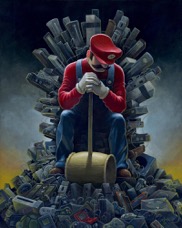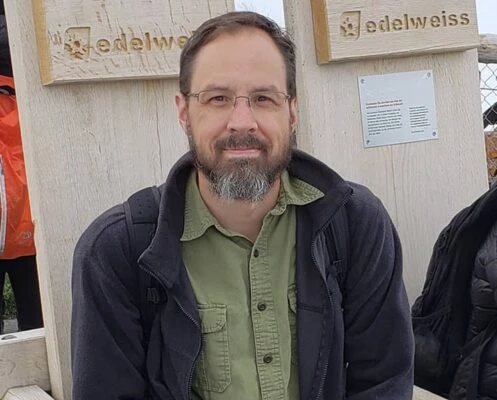
The work of artist Julia Griffin graces the cover of this month’s Apex Magazine. Her elegant, story-driven works, often covering mythology and fairy tales, are enchantingly rendered in colored pencils.
APEX MAGAZINE: Your cover art for this month seems to integrate the creator with their creation. Do you see yourself as another side, sort of an “Inception” of your level, then turning to create the creator? How have others interpreted the piece, or commented on it?
JULIA GRIFFIN: With this piece I wanted to play with the idea of art as a portrait of the artist. I don’t like to talk about myself much, but you can learn a lot about me by looking at my work. I think many artists are like that. The artist in this piece is trying to hide behind her art, but through the process of creation, is unconsciously revealing herself to the viewer. I also love the insinuation that the viewer could also be a creation of the artist, although I didn’t initially intend it!
AM: One of your Instagram posts features your table at Illuxcon this past October. How do events like that, especially surrounded by so many other artists, affect your work when you get home? Do you get to spend time talking shop with other artists, perusing their booths, or even finding new styles you haven’t seen before?
JG: Events like Illuxcon are incredibly helpful to me. Working in isolation most of the time is tough, and events give me a chance to revive my motivation and find inspiration. I return home from them reinvigorated and ready to get to work. I talk with other artists about process, media, and just what they’re up to. There’s always so much amazing work to see! I come home with new ideas, art supply recommendations, and the drive to create something new.
AM: You mentioned in the comments of your charcoal piece “Blindness,” for the Month of Fear challenge, that it is the creepiest thing you have drawn. When you are creating a piece that challenges the viewer, how do you balance the effect so that it doesn’t come off as too little or too much? For horror, or even surreal, images from other artists, what techniques or ideas affect you?

JG: When I make creepy work, I usually aim for more subtle than overt. I want the viewer to find the piece unsettling, maybe it takes them a moment to realize that something is off. Different people find different things frightening, and the human imagination is very powerful. So if I’m trying to challenge the viewer, I hide or obscure certain visual cues or leave them unfinished. When it comes to horror, I’m interested in the unease caused by contrasting the familiar with the unknown, taking something familiar and exaggerating some element of it until it becomes uncanny.
AM: One of your other appearances is online on the marvelous Every Day Original site, where a number of your creations have been featured. What are the pros and cons of selling online versus sales in person at a convention or gallery show? Is there a difference in the audience, as far as what they might be looking for either in content or physical type and size of art?
JG: I can reach a whole different audience selling online, art collectors who live in other countries or other people who don’t have access to galleries and conventions. However, online sales lack the personal connection I could find at a convention. I have less experience selling in galleries, but it seems that buyers at gallery shows tend to gravitate toward larger works than buyers at conventions or online. Every Day Original deals almost exclusively in small, affordable art, which definitely appeals to online buyers.
AM: The Children’s art gallery on your website features pieces that have marvelous emotion and substance. Especially after working on your self-published version of Hans Christian Andersen’s The Snow Queen, are you looking to do more illustrations based on children’s stories? What motivates you when it comes to a story like that? What are you hoping to bring to the table?
JG: I would love to do more children’s book illustration, and have a couple of projects on the back burner that I plan to go back to. I think instilling a love of reading in children is important, and illustrations help draw a child into the story. Children’s stories, especially fairy tales, inspire a sense of wonder and curiosity about the world and I want my illustrations to do the same!
AM: Thank you to Julia Griffin for an insightful interview of her experience as an artist. You can find more of her beautiful art on her website at www.juliagriffinart.com.








